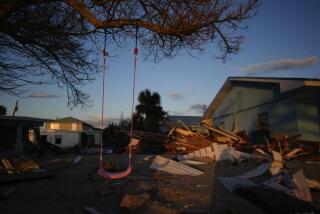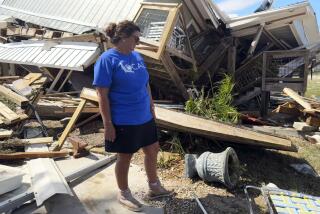L.A. Takes Page From Florida’s Harsh Lessons
Tent City, Lanark Park. Hundreds of the newly homeless wait in the afternoon sun as relief workers hand out milk, shampoo, oranges and canned food. Camouflage-clad soldiers play catch with little children. Fraternity brothers from Pepperdine flip burgers on a grill. Older folks retreat to their tents to steal some much-needed sleep.
Cindy McCain, head of a team of volunteer physicians from Phoenix surveyed this organized chaos and felt a twinge of deja vu. On back of her red T-shirt was: “Hurricane Andrew, 1992.”
With long food lines, makeshift disaster assistance centers and olive drab military encampments dotting the landscape, parts of Los Angeles are beginning to resemble South Florida in the wake of the hurricane, which until last week’s quake was the country’s costliest natural disaster. Sensing the parallels, Southland authorities--from school officials to the mayor to relief workers such as McCain--are tearing a page from Andrew’s lesson book.
They are learning as much about what not to do as what to do. In the wake of the hurricane, Florida’s tent cities remained up for more than two months, and one was reopened six months later when authorities discovered that 5,000 people were still homeless. Mayor Richard Riordan has vowed that will not happen in Los Angeles.
“We look at the dark side of what happened in Florida and that is the inability, in the short term, to put people in permanent housing,” said Geoffrey Garfield, the assistant deputy mayor who is overseeing the city’s earthquake emergency operations center. “We are making our moves very aggressively to not have that happen here.”
Relief agencies, remembering how quickly food rotted in the hot Florida sun, have urged donors to deliver non-perishable goods--or better yet, to send cash. The Federal Emergency Management Agency, sorely criticized for its slow response to the hurricane, arrived in Los Angeles within hours of the quake.
Officials from United Teachers-Los Angeles, meanwhile, have been working the phones, calling their South Florida counterparts for advice. They say they have received several crucial tips: To get mental health counselors into the schools immediately, to reshuffle teaching assignments so that commutes are shortened, and to request emergency help from the Seabees--a Navy construction battalion--who could rebuild damaged schools.
“They made us think that maybe it wasn’t just a dark tunnel,” said union Vice President Denise Rockwell-Woods, “and that maybe we wouldn’t be in bad shape for years and years to come.”
But if Florida history is any guide, Los Angeles may take longer to recover--physically, and especially, psychologically--than many people think. The people of South Florida have learned that nature leaves a heavy footprint.
“I think there are going to be some problems here stretching out for the rest of this century,” said Charles Blowers, chief of the research division for the Dade County planning department.
Today, nearly 18 months after the hurricane, 18,000 housing units--more than-one third of those rendered uninhabitable by the storm--have still not been repaired. A major shopping mall has not reopened. Four schools were leveled by the hurricane and have not been rebuilt; students attend classed in mobile trailers. At other schools, there have been only patchwork repairs.
Some businesses that shut down will probably never come back. Many people moved out of the region and will not return; county planners estimate that by 2000, the population will be 20,000 fewer than if the hurricane had not hit. And FEMA still has not come forth with some low-interest loan money it promised.
“FEMA is very cooperative at first,” said Cynthia Curry, Dade County’s hurricane recovery coordinator. “But once time passes, when the threat to lives is not so apparent, then different people take a look at previous decisions and the likelihood of reimbursement decreases.”
Some damaged apartment complexes were never rebuilt, creating a patchwork of empty lots. Alex Muxo, city manager of Homestead, the area hardest hit by the storm, says the owners of more than 800 apartments simply took the insurance money, paid off their mortgages, cleared their property and left it vacant.
The storm wiped out 43% of Homestead’s tax base, and drove at least 8,000 of the city’s 28,000 residents out of the area for good. Meanwhile, FEMA still keeps 1,000 trailers in the area to house an estimated 3,000 to 4,000 people left homeless by the storm.
Tom Reale, his wife, Jackie, and their two young children are living in one of those trailers. Tom, 47, is a plumber whose business has gone to seed while he works on repairing his house. The family is living on the money saved for the children’s college tuition, and Jackie is receiving unemployment benefits.
“Unless you’ve been through this, you can’t imagine what it’s like,” Tom Reale said. “What has it been? Eighteen months now, and we’re still not back in. That’s a hell of a long time to have your life totally upturned.”
Reale’s neighborhood is crisscrossed with Andrew’s scars--abandoned homes, boarded-up businesses and vacant lots where stores once stood. The wind-swept landscape is dotted with more trailers than trees, and the trees that were not uprooted are stumpy and short. Watching the news from Los Angeles brings back painful memories of long lines at FEMA centers and Red Cross stations.
“Once is enough for anybody,” Reale said.
The emotional trauma of the hurricane has run far deeper than many in South Florida initially anticipated. In the school system, the number of referrals to a counseling program for teachers quadrupled last year. Crisis counselors are still stationed in schools to cope with the fallout among students.
A University of Miami psychologist who followed 560 third- and fifth-graders after the quake said that one year later a third were still experiencing moderate to severe signs of stress.
“Many of the children in our sample reported feeling more alone,” said the psychologist, Annette La Grega. She added that many youngsters refused to visit neighborhoods that were severely damaged by the storm, and some reported that they were unable to concentrate as well at school because memories of the hurricane interfered.
Already in Los Angeles, evidence is pointing to a similar psychological toll. Now that the immediate injuries caused by the quake have been tended to, said Pamela Spencer, a spokeswoman for Kaiser Permanente in Woodland Hills, “the biggest medical issue that we’re seeing is mental trauma--post-traumatic stress.”
Of course, no two disasters are alike, and the fallout from the Northridge quake--which federal officials say is the costliest disaster in U.S. history, surpassing Andrew’s $30-billion toll--will not precisely mirror that of the hurricane. In South Florida, the destruction was concentrated in one area. In Southern California, it is scattered across the urban sprawl of Los Angeles County and the suburbs of Ventura County.
Although transportation was difficult in the immediate aftermath of Andrew, there was nothing on the order of the collapsed freeways that are creating nightmarish traffic in Los Angeles. The hurricane, meanwhile, created huge amounts of debris--more than enough to fill a chain of 18-wheel big-rigs parked bumper-to-bumper from the Empire State Building to the Golden Gate Bridge and back again. Los Angeles’ debris problem is not likely to be that severe.
What the two disasters have in common are the huge numbers of people they displaced. On this score, residents of South Florida took a harder hit. Andrew destroyed 48,000 housing units, leaving an estimated 100,000 homeless. Thus far, inspectors in Los Angeles have declared at least 14,500 housing units uninhabitable, a figure that does not include damage outside the city limits.
With so many people pushed out of their homes, Mayor Riordan was forced, reluctantly, to do what officials in South Florida had done: permit the military to set up makeshift tent cities. As of Monday, an estimated 3,500 weary earthquake refugees were living in the four National Guard encampments in San Fernando Valley parks, including the one at the Lanark Recreation Center in Canoga Park.
The Florida tent city experience was not a positive one. “Tents are not a long-term solution,” said Andy Menendez, director of homeless programs for Dade County. “They are a long-term headache.”
Those who moved into the Florida tent cities brought with them many of the problems that plague society: dysfunctional families, substance abuse and unemployment. Also, the so-called chronic homeless--people who lacked housing before the storm--moved in, attracted by free shelter and the promise of three meals a day.
Living in close quarters, people already traumatized by the storm and the loss of their homes were prone to squabbles. Sexual liaisons formed, and that led to problems. Sometimes, violence erupted.
There were three tent cities in South Florida, erected by the military and run by FEMA, sheltering 3,000 people. (The Los Angeles tents, although put up by the National Guard, are being run by civilians--the Salvation Army.) The South Florida encampments were taken down in November, 1992, more than two months after the storm--too quickly, in Menendez’s opinion.
In February, 1993, after his office took a survey and found 5,000 people still homeless, Dade County got into the tent city business. With borrowed FEMA tents, the county re-erected a tent city for 500. But without federal funds or military help, the county had to buy ready-to-eat food, provide private security, rent portable toilets and pay for day-care services.
Despite all the problems with tent cities, Menendez said Dade County would have been better off leaving them in place until everyone found permanent housing. “The first lesson,” Menendez said, “is that regardless of what FEMA or anyone else says, those tents should not be dismantled until everyone is convinced there is no need.”
Mindful of that experience, Riordan staffers say the mayor is determined to relocate the displaced and take down the tent cities--which they call “short-term transitional centers”--as soon as possible.
With 830 building inspectors fanning out across the quake-devastated region, plus “reassurance teams” designed to coax people into going back to apartment buildings that have been declared safe, Riordan’s office predicts that the encampments may come down as soon as next week.
The mayor’s office says the comparison to South Florida is not apt, because there are enough vacant apartments in Los Angeles to house the displaced.
“We are moving aggressively to put people in these vacant apartments,” said Garfield, the assistant deputy mayor for public safety. “Our thing is to get people back into their own homes. The tents are not permanent.”
Times staff writer Sheryl Stolberg reported from Los Angeles. Mike Clary reported from South Florida.
* RELATED COVERAGE: B1-B3, D1
More to Read
Sign up for Essential California
The most important California stories and recommendations in your inbox every morning.
You may occasionally receive promotional content from the Los Angeles Times.










